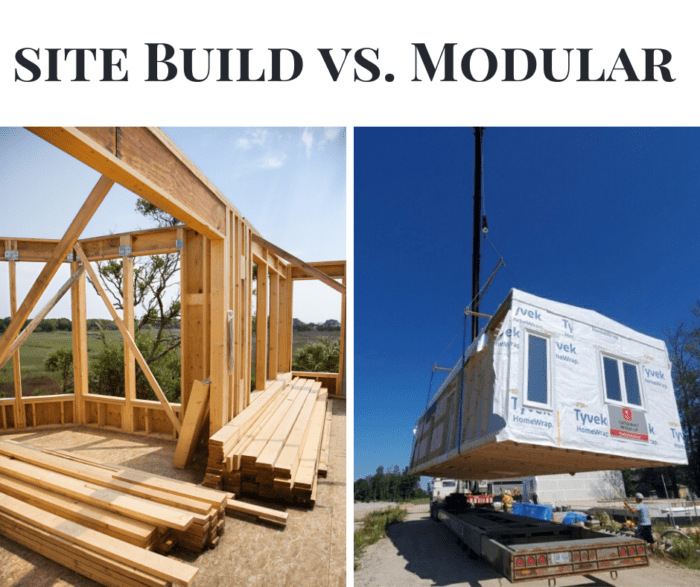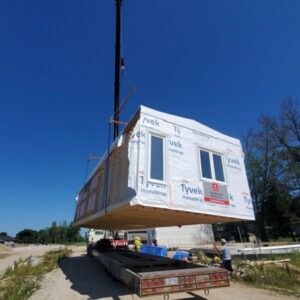Choosing between a site built home and a modular (also known as a manufactured a home) is a highly personal process. It’s also perhaps one of the most important and potentially valuable decisions you’ll ever make. No pressure! There are some things though that you can do to ensure you are making a well-informed and confident decision. In this post, we’ll put the two building types side by side and show you how to determine which is best for you.
Disclaimer: I’ve mentioned before that I’m not an expert in the field of home construction so I took a bit of time to do some extra research for you. As a result, this post is loaded with information to help you make the best choice for you and your new home. Special thanks to James Rouse Custom Builders and Quality Homes for their input on this post so I can be sure to provide the best information to you.
But first, let’s be clear on the definition for each:
What is a Site Built Home?
Site Built Homes are often called stick build homes or custom homes. I hesitate to use the term custom home now that I know that many manufactured homes can also be highly customized. A site built home is simply a home that is built entirely in place, on your site.
What is a Manufactured Home?
Manufactured homes may also be called engineered homes or modular homes. These homes are built in parts in a factory, shipped to your site on specialized trucks and lifted into place by crane. If your model is built in more than one part, they are then “stitched” together. I think “modular” seems like the most accurate term to me considering the construction process.
Shall we get to the good stuff? I thought so!

Comparing the Advantages of Site Build and Manufactured Homes
Advantages of a Site Built Home:
In my last post about the Site Built Home I didn’t feel like I demonstrated an objective portrayal of the benefits so I wanted to be sure to give you one here. This time I’m reaching out to another local builder for some help to keep me on task. Let’s take a look at some of the advantages, and possible disadvantages of a site built home.
- You can build any style, and any size you could imagine. The sky really is the limit to what you can build with a site built home – local restrictions and good engineering notwithstanding.
- You can build anywhere you like – within your site limitations and municipal guidelines of course.
- You can source your materials from anywhere you like. You’re more likely to care about this in the finishes but if you and your builder are resourceful, you can make anything on your wish list a reality.
- You have the choice to be as involved or not as you like in the management of your project. Please note, if you are not familiar with the construction process, let your contractor do the heavy lifting on the management side. You don’t want to be that customer that creates more trouble for your project with inserting yourself where you have no valuable knowledge. There’s a good chance that your project will experience more delays and cost over-runs if you are constantly questioning and over-riding your contractor’s expertise. If you’re not going to be confident in their decisions and processes, find another builder NOW!
- You have a greater opportunity to support our local economy since most builders are using local trades, labour, and material sources in all phases of the build.
Advantages of a Manufactured Home Build
- You don’t have to deal with architects or engineers to come up with the blueprints you need for permits or the build itself. The manufacturer has this service built in to their process.
- There’s less chance of cost overruns with a manufactured home build. A home manufacturer can do this because they negotiate bulk purchase of building materials well in advance of your build. They also have their work force all in one place, so they can make further economies with their labour. For example they can use general labourers for a lot of work a tradesperson or journeyman would do on a site build. In addition, many manufactured home builders’ pricing includes a poured concrete foundation, finishes that would be considered upgrades elsewhere, air blower test, permit coordinator & drafting services, a dedicated site supervisor, and so much more. All of these together help control your costs and overruns.
- There are fewer things that can affect the schedule for the delivery of a manufactured home. In fact, it’s usually something in the customers’ scope that could make the biggest impact to the schedule, like not having the site prepared in time for the equipment to come in.
- Project Coordination – The whole building process is a well-orchestrated repeatable one. It has to be so that the builder can complete more builds in a year than a typical site build builder. This gives the customer peace of mind that things are handled exactly in time for when they’re needed. The builder will guide you through what they need you to do but for the most part, there’s not much project management required on your part.
- There are fewer carbon emissions and there is less waste during the building process. I was shocked to find this point highlighted in this article on the provincial website. If environmental impact of your build means a lot to you, this could be an important factor.
- Generally speaking, the quality of the build is nearly unbeatable. Using Quality Homes as a sample builder, your home is being built in an indoor, climate controlled facility, every home is CSA certified and goes through a 400-point quality standard inspection, materials are protected from the elements so they stay straight and true with no damage. After our factory tour at Quality Homes, and seeing their processes, I have no doubt that these claims are accurate. My parents built a Royal Home over 35 years ago and it’s still standing strong and true. Please be sure to check with your individual builder to ensure they can meet these same standards for you.


Comparing the Disadvantages of Site Build and Manufactured Homes
Disadvantages of a Site Built Home
Note: Many of these will depend greatly on who you choose as a builder. As you’re interviewing builders, be sure to discuss each of these items until you have peace of mind with your choice.
- Availability of trades & subcontractors – Unless your builder has in-house trades and all the specialty equipment a build needs, you could be competing with other builds for their time. This can make your schedule more fluid than you might like.
- Prices for materials may fluctuate. Since 2020/2021, the supply of many building materials has been more unstable than usual. This too can impact your overall project costs and schedule. Many builders are only guaranteeing quoted pricing for a short time because material costs are constantly changing. Hopefully the supply chain will start to stabilize soon so this disadvantage can disappear.
- Your building materials will most likely spend a fair of amount of time exposed to the elements while on the job site. I know technology and building practices have come a long way but I’m still not too keen on the idea of the wood for walls getting wet, or plywood being exposed for any length of time. Sometimes it’s still the thought that counts.
Disadvantages of a Manufactured Home Build
I know I play up this type of build like there couldn’t possibly be a disadvantage but there may be a few.
- They can’t be built just anywhere. Not every site can provide the access that the trucks and cranes need.
- There are limitations on the size and structure of the build since the modules have to be built to accommodate transportability. That doesn’t mean you’re limited to just one or two modules though. It only means that the roof pitch of a single story home or the support for open concept (for examples) may be limited.
- They can’t be built as slab on grade. Since the modules need to be built on box (joist) floors, slab on grade is out of the question.
- You’re not as involved in the build process! Since your home is being built in a factory, you won’t be driving to your lot every week to see the progress. I’m discovering that while there is still excitement and involvement, it doesn’t seem to be as constant or build in quite the same way it likely would on a site build. Yes, I am aware of that irony that it’s a pro and a con here. Ask me in a few months, when we go for our selection day, or have to get permits and prepare the site for delivery, if I still feel this way.
Now, let’s see how they stack up side by side, feature by feature!
Site Build & Manufactured Homes: Side by Side Feature Comparison
| Feature | Site Build | Manufactured |
|---|---|---|
| Design | Limited only by local restrictions & your imagination | Limited only by transportability & your imagination |
| Structure | Unlimited | Limited only by transportability |
| Site Location | Unlimited | Limited by site access for float trucks and crane. |
| Project Management | Negotiable | Limited |
| Schedule Variability | Fluid | Limited |
| Cost Variability | Possible throughout | Limited by finishes you choose |
| Material Exposure to Elements | Likely | None |
| Average Time to Build | 6 – 9 months – from ground breaking to finish. | 3-4 weeks in factory, 2-4 months on site to finish (depends on the model/design) |
| Supports Local Economy | YES! | If the builder is close to your site, then yes. Otherwise, only for site preparation services. |
Now that you’re armed with some of the key pro’s and con’s, you can do your own comparison! The headings below are identical to the above but you’ll fill in your own grading system according to your personal priorities. You can use this to compare different types of builds or two of the same type of builder since they all have slightly different ways of operating.
| Feature | Site Build | Manufactured |
|---|---|---|
| Design | ||
| Structure | ||
| Site Location | ||
| Project Management | ||
| Schedule Variability | ||
| Cost Variability | ||
| Material Exposure to Elements | ||
| Average Time to Build | ||
| Supports Local Economy |
As I mentioned at the very start, choosing between a site built home and a modular (also known as a manufactured) home is a highly personal process; one you want to get right. Using a comparison based on your values and priorities will allow you to confidently move forward with the building of your new home!
Special thanks to James Rouse Custom Builder Ltd. James Rouse continues the family Custom Building & Renovation tradition, a legacy of building and customer service excellence established by his great grandfather 60 years ago and continued by his grandfather (and mentor) using current building codes and advances in building materials and technology.
Special thanks also to Monica at Quality Homes where every stage of the building process is clean and precise. Our production facility is equipped with state-of-the-art automated custom cutting and framing equipment. Cuts are perfect. Alignment is exact. Every fastener is arrow straight.
Recent Posts
7 Totally Selfish Reasons to Choose Native Plants for Your Gardens
Grab a cup (or glass) of your favorite beverage, and let's delve into what I’ve learned so far about why it's incredibly important and wildly selfish to embrace landscaping with locally native...
Exploring the differences, benefits and drawbacks of Broadcast Sowing and Frost Seeding for Native plants.

